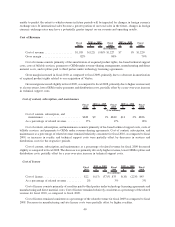Symantec 2010 Annual Report Download - page 107
Download and view the complete annual report
Please find page 107 of the 2010 Symantec annual report below. You can navigate through the pages in the report by either clicking on the pages listed below, or by using the keyword search tool below to find specific information within the annual report.we cannot reasonably estimate the amount of excess inventory that will be returned, we primarily offset deferred
revenue against trade accounts receivable for the amount of revenue in excess of the expected inventory levels.
Arrangements for managed security services and SaaS offerings are generally offered to our customers over a
specified period of time, and we recognize the related revenue ratably over the maintenance, subscription, or service
period.
Reserves for product returns. We reserve for estimated product returns as an offset to revenue based
primarily on historical trends. We fully reserve for obsolete products in the distribution channels as an offset to
deferred revenue. If we made different estimates, material differences could result in the amount and timing of our
net revenues for any period presented. More or less product may be returned than what was estimated and/or the
amount of inventory in the channel could be different than what was estimated. These factors and unanticipated
changes in the economic and industry environment could make actual results differ from our return estimates.
Reserves for rebates. We estimate and record reserves for channel and end-user rebates as an offset to
revenue. For consumer products that include content updates, rebates are recorded as a ratable offset to revenue over
the term of the subscription. Our estimated reserves for channel volume incentive rebates are based on distributors’
and resellers’ actual performance against the terms and conditions of volume incentive rebate programs, which are
typically entered into quarterly. Our reserves for end-user rebates are estimated based on the terms and conditions of
the promotional programs, actual sales during the promotion, amount of actual redemptions received, historical
redemption trends by product and by type of promotional program, and the value of the rebate. We also consider
current market conditions and economic trends when estimating our reserves for rebates. If actual redemptions
differ from our estimates, material differences may result in the amount and timing of our net revenues for any
period presented.
Valuation of goodwill, intangible assets and long-lived assets
When we acquire businesses, we allocate the purchase price to tangible assets and liabilities and identifiable
intangible assets acquired. Any residual purchase price is recorded as goodwill. The allocation of the purchase price
requires management to make significant estimates in determining the fair values of assets acquired and liabilities
assumed, especially with respect to intangible assets. These estimates are based on information obtained from
management of the acquired companies and historical experience. These estimates can include, but are not limited
to, the cash flows that an asset is expected to generate in the future, the appropriate weighted-average cost of capital,
and the cost savings expected to be derived from acquiring an asset. These estimates are inherently uncertain and
unpredictable, and if different estimates were used the purchase price for the acquisition could be allocated to the
acquired assets and liabilities differently from the allocation that we have made. In addition, unanticipated events
and circumstances may occur which may affect the accuracy or validity of such estimates, and if such events occur
we may be required to record a charge against the value ascribed to an acquired asset or an increase in the amounts
recorded for assumed liabilities.
Goodwill. We review goodwill for impairment on an annual basis on the first day of the fourth quarter of each
fiscal year, and on an interim basis whenever events or changes in circumstances indicate that the carrying value
may not be recoverable, at the reporting unit level. Our reporting units are consistent with our operating segments.
Before performing the goodwill impairment test, we first assess the value of long-lived assets in each reporting unit,
including tangible and intangible assets. We then perform a two-step impairment test on goodwill. In the first step,
we compare the estimated fair value of equity of each reporting unit to its allocated carrying value (book value) of
equity. If the carrying value of the reporting unit exceeds the fair value of the equity associated with that unit, there
is an indicator of impairment and we must perform the second step of the impairment test. This second step involves
determining the implied fair value of that reporting unit’s goodwill in a manner similar to the purchase price
allocation for an acquired business, using the reporting unit’s calculated fair value as an assumed purchase price. If
the carrying value of the reporting unit’s goodwill exceeds its implied fair value, then we would record an
impairment loss equal to the excess.
The process of estimating the fair value and carrying value of our reporting units’ equity requires significant
judgment at many points during the analysis. Many assets and liabilities, such as accounts receivable and property
and equipment, are not specifically allocated to an individual reporting unit, and therefore, we apply judgment to
31
























